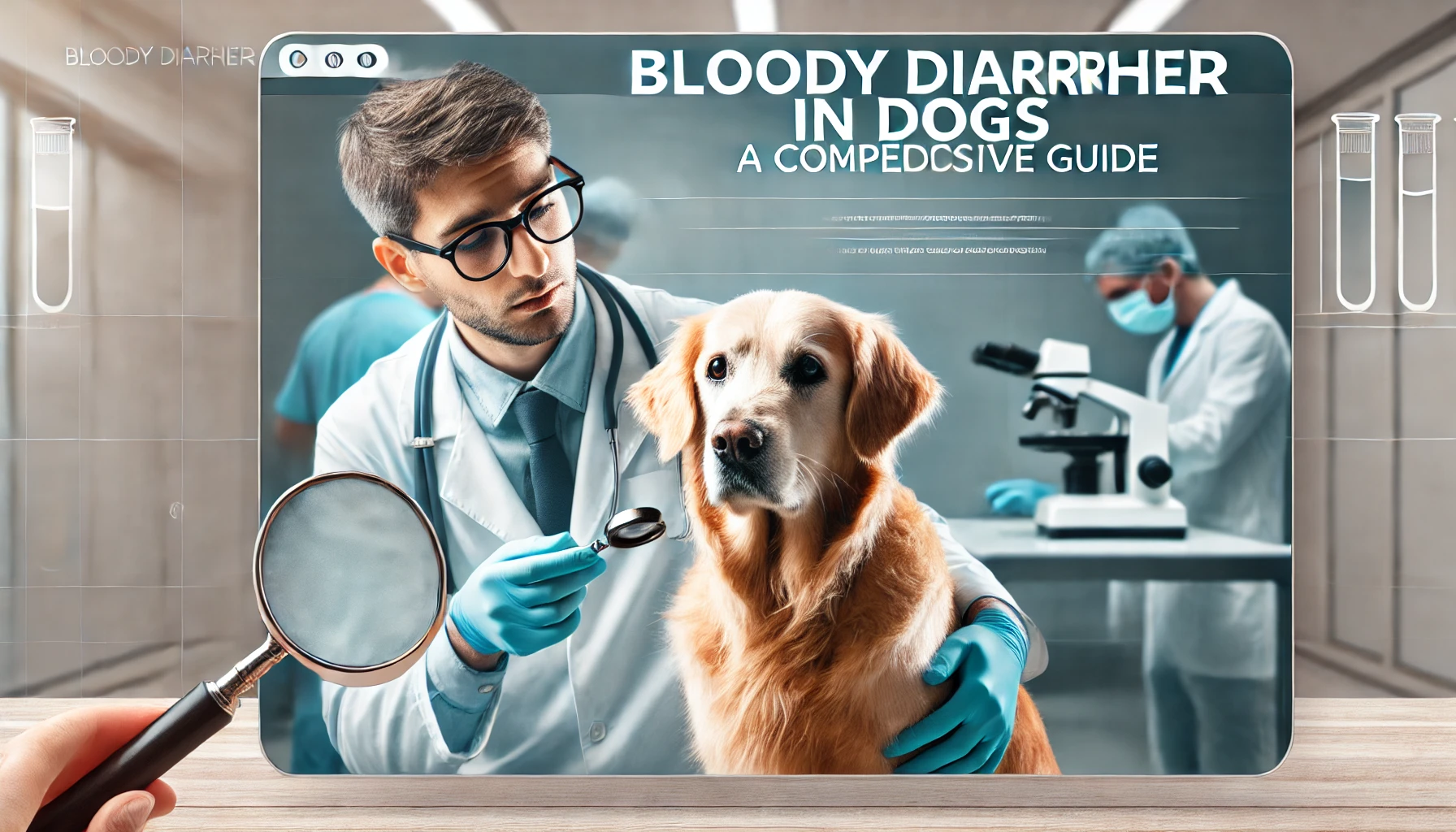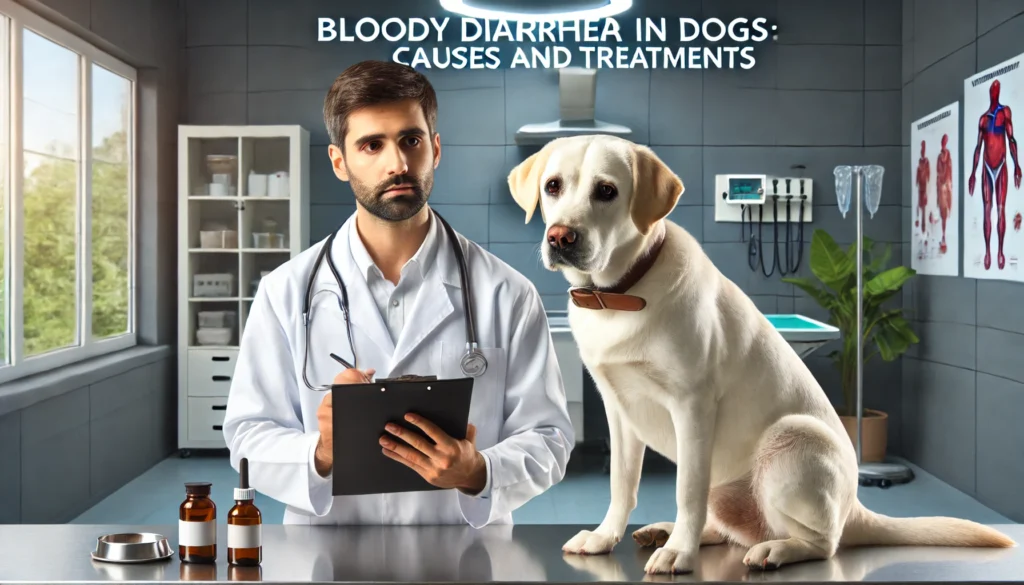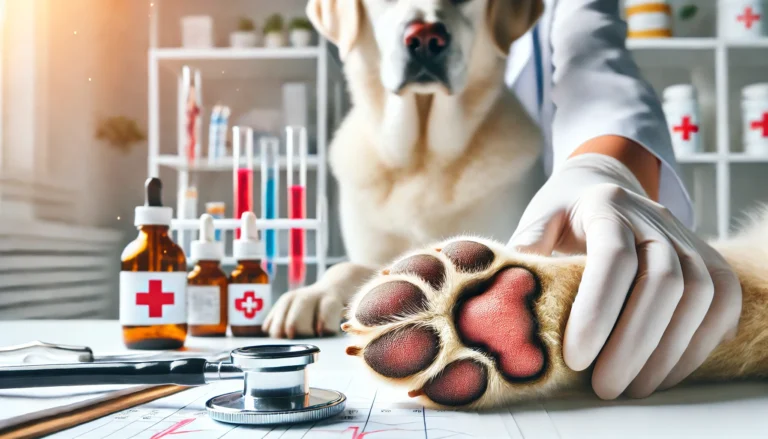Bloody Diarrhea in Dogs: A Comprehensive Guide

know about the Bloody Diarrhea in Dogs
When your furry friend starts showing signs of bloody diarrhea, it can be a distressing experience. Bloody diarrhea in dogs, medically known as hematochezia or melena depending on the blood’s appearance, is not a disease itself but a symptom of various underlying conditions, some of which require immediate medical attention. Understanding the causes, identifying the symptoms, and knowing when to visit your vet are crucial steps in effectively addressing this alarming sign.

What is Bloody Diarrhea in Dogs?
Bloody diarrhea is a condition characterized by the presence of blood in the stool, which can appear either bright red or very dark, almost black in color. The distinction in color is significant as it helps pinpoint the location of the bleeding within the gastrointestinal tract.
- Hematochezia: This is the presence of bright red blood, indicating that the bleeding is occurring in the lower gastrointestinal tract, such as the colon or rectum.
- Melena: This condition presents as black, tarry stools, which suggest that the bleeding is originating from higher up in the gastrointestinal tract, such as the stomach or small intestines. The black color is due to the digestion of the blood as it passes through the intestines.
Common Causes of Bloody Diarrhea
There are multiple reasons why a dog might develop bloody diarrhea. These range from relatively mild conditions to more severe illnesses:
- Dietary Indiscretion: Consuming inappropriate items like garbage or spoiled food can upset a dog’s digestive system.
- Parasites: Hookworms, whipworms, and Giardia are common parasites that can cause bloody stools.
- Infections: Viral and bacterial infections, such as parvovirus or salmonella, are serious causes of bloody diarrhea.
- Chronic Conditions: Diseases like colitis, inflammatory bowel disease, and certain cancers can lead to recurring episodes.
- Toxins: Ingestion of toxins or poisons can rapidly cause severe symptoms including bloody diarrhea.
- Stress: Dogs can develop stress colitis, leading to inflammation and bloody diarrhea, often seen in highly anxious or stressed pets.
- Medications and Allergies: Certain medications, or allergies to specific foods, can result in gastrointestinal upset and bloody stools.
Symptoms Accompanying Bloody Diarrhea
In addition to bloody stools, dogs may show other concerning symptoms which need immediate attention:
- Vomiting
- Lethargy
- Fever
- Abdominal pain
- Loss of appetite
- Dehydration
- Increased urgency to defecate
- Weight loss (in chronic cases)
These symptoms can indicate a more serious underlying condition, necessitating a prompt veterinary visit to avoid complications.
DO YOU KNOW
Low-fat cheeses, like cottage cheese or mozzarella, can be better choices for a canine diet. Yet, even these should be given sparingly to avoid any issues from the residual lactose or fat content.
Diagnosing Bloody Diarrhea
To diagnose the cause of bloody diarrhea, a veterinarian will conduct a thorough physical examination, review the dog’s medical history, and recommend specific diagnostic tests. These may include:
- Fecal examination: To check for parasites or microbial infections.
- Blood tests: To assess overall health and rule out infections or organ dysfunction.
- Ultrasound or X-rays: To visualize the abdominal area for signs of blockages, tumors, or other abnormalities.
- Endoscopy: For a direct look at the gastrointestinal tract to detect inflammation, ulcers, or tumors.
Treatment Options
The treatment of bloody diarrhea in dogs depends largely on the underlying cause:
- Dietary Management: For mild cases without a serious underlying condition, a temporary shift to a bland diet (like boiled chicken and rice) might be recommended.
- Parasitic Treatments: If parasites are the cause, appropriate antiparasitic medications will be administered.
- Antibiotics or Antivirals: These are used if a bacterial or viral infection is identified.
- Fluid Therapy: To prevent dehydration, particularly if the dog has been vomiting or has severe diarrhea.
- Surgery: In cases where tumors, blockages, or severe intestinal damage are found, surgical intervention may be necessary.
Preventive Measures
Preventing bloody diarrhea involves:
- Regular Parasite Control: Keeping up with regular deworming treatments and flea control.
- Proper Diet: Feeding your dog a balanced diet suited to their age, breed, and health status.
- Avoiding Stress: Maintaining a stable environment can help reduce the risk of stress-induced colitis.
- Routine Health Checks: Regular veterinary visits for health checks can catch many conditions before they become severe.
When to See a Vet
Immediate veterinary care is recommended if your dog exhibits signs of bloody diarrhea, especially if accompanied by vomiting, fever, lethargy, or a decrease in appetite. Early diagnosis and treatment can significantly improve the prognosis, depending on the underlying cause.
Conclusion of Bloody Diarrhea in Dogs
Bloody diarrhea in dogs is a symptom that should never be ignored. While sometimes the cause might be minor, it can also be indicative of a life-threatening condition. A responsible approach involves prompt veterinary consultation to ensure the health and well-being of your beloved pet. With the right care and attention, many dogs recover well from the conditions associated with bloody diarrhea, leading to a healthy and happy life.
FAQs on Bloody Diarrhea in Dogs
Can a dog survive parvo after pooping blood?
Yes, dogs can survive parvo after exhibiting severe symptoms like bloody diarrhea, but immediate and intensive veterinary care is crucial to improve their chances of recovery.
Why is my dog pooping blood but acting fine?
Some conditions causing blood in stool may not immediately affect your dog’s demeanor, such as minor dietary irritations or early-stage internal parasites. Nonetheless, any occurrence of bloody stools warrants a vet check to rule out serious conditions.
Is bloody diarrhea in dogs an emergency?
Yes, bloody diarrhea in dogs should be considered an emergency. It can indicate serious underlying conditions such as parvovirus, poisoning, or hemorrhagic gastroenteritis, all of which require urgent veterinary attention.
What does blood in dog’s diarrhea mean?
Blood in a dog’s diarrhea can indicate several issues, from infections and parasites to more severe conditions like cancer or coagulation disorders. It is essential to have this symptom evaluated by a vet promptly.
What can I give my dog to stop bloody diarrhea?
It is best not to give any over-the-counter medications without consulting a vet. Depending on the cause, the vet may prescribe specific treatments like fluids, antibiotics, or anti-parasitics.
How to treat hemorrhagic gastroenteritis in dogs at home?
Hemorrhagic gastroenteritis (HGE) requires veterinary supervision. At home, follow your vet’s guidance, which may include administering prescribed medications and offering a bland diet after initial fasting.
Can a dog survive hemorrhagic gastroenteritis?
Yes, with prompt veterinary treatment, most dogs can survive hemorrhagic gastroenteritis. Treatment typically involves fluid therapy and medications to stabilize the condition.
What is the fastest way to cure gastroenteritis in dogs?
Quick treatment from a vet is the fastest way to address gastroenteritis in dogs. This will likely include fluid therapy to address dehydration and medications to treat the underlying cause of the gastroenteritis.
What food is good for dogs with hemorrhagic gastroenteritis?
A bland diet, typically consisting of boiled chicken and rice, can be beneficial for dogs recovering from hemorrhagic gastroenteritis. This diet is easy on the stomach and helps in gradual recovery.
Is chicken and rice good for dogs with bloody diarrhea?
Yes, chicken and rice are often recommended for dogs with bloody diarrhea as they are gentle on the stomach and provide easily digestible nutrients that help in recovery. Always ensure the chicken is cooked plain, with no seasoning, oils, or onions/garlic.






